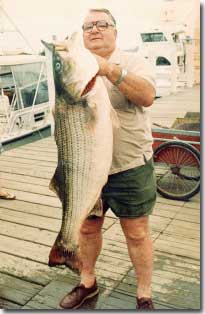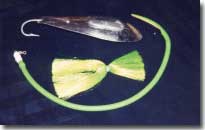Striped Bass Trolling 101
Striped Bass Trolling 101
 How many times have you heard other fisherman tell you that trolling for striped bass with wire line is just a matter of rambling around until something jumps on. Well, as far as I’m concerned, nothing could be farther from the truth. Trolling for striped bass, Montauk style, is the most exacting, most demanding type of fishing that there is. A captain that consistently produces pass after pass has paid his dues over the years. He must know what type of tackle is best suited for the job, what lure to fish and how to rig them, what tides work best on every spot, how to make the pass that will get his lures down to where the fish are living and most important the spots themselves and the ranges that will take his lure over that spot. How many times have you heard other fisherman tell you that trolling for striped bass with wire line is just a matter of rambling around until something jumps on. Well, as far as I’m concerned, nothing could be farther from the truth. Trolling for striped bass, Montauk style, is the most exacting, most demanding type of fishing that there is. A captain that consistently produces pass after pass has paid his dues over the years. He must know what type of tackle is best suited for the job, what lure to fish and how to rig them, what tides work best on every spot, how to make the pass that will get his lures down to where the fish are living and most important the spots themselves and the ranges that will take his lure over that spot. Let’s look first at the tackle we need to get us started. A light action rod about 6’4" in length with carballoy guides (preferably the braced kind) and either a wood butt that’s fitted with a machined reel seat and a gimbel knok or if you prefer an aluminum Unibutt. The latter is too heavy for my taste however several captains us them as they last forever. The reel of choice for wire lining is the Penn 113HSP. Don’t ever use a reel with an aluminum spool. It will electrolyze with the wire line and ruin everything. Finally the line and leader, and this varies with each captain. Each reel should have at least 300’ of wire line. My reels all have 350’ of .028 type 304 Stainless, marked every 50’ with at least 200 yards of 80 pound test monofilament backing. Some captains use .025, some use .032, and a few still use Monel instead of stainless. Monel is cost prohibitive to me. It is three time the price of stainless and I don’t feel it lasts any longer than stainless. The captains who use Monel will argue that its benefits outweigh the cost. I’ll stick with the stainless. Your leader should be at least 50 pound test Mono. I use 80; some captains prefer 125. It’s a matter of choice. If the Bluefish are thick the boats with the 125 pound test definitely will loose less lures. About 30’ is a good length connected to the wire with a No. 5 barrel swivel. OK. Now that you’ve got your rod and reel set up, let’s get down to the business end of your line. What are we going to catch these stripers on? In Montauk, probably the lure that takes the most bass is a 2 oz. Chartreuse Andrus Parachute Jig with a strip of Uncle Josh 70s red pork rind. And of course, don’t forget to split the tail. Umbrella rigs, single surgical tube and bunker spoons also take their share of fish. The big tubes and the spoons are particularly good if you’re looking to catch bigger fish. Not that jigging parachutes doesn’t catch big bass, it certainly does. The biggest that I ever reeled in personally was a 57 pounder that fell to a white parachute while trolling on the Tube Monster, one of my favorite spots. Now we have everything we need to go out and catch a striper. Lets assume that we’re fishing a rocky lump that comes up to 25’ surrounded by 40’ of water. We want to put out 250’ of wire to get us into the feeding zone of the bass. When fishing wire the standard rule of thumb is 10’ down for every hundred feet of wire you put out. There are many variables to this rule. Boat speed, tide and wind velocity and direction all are factors that will affect the dept of your lure. Just remember this; you want to have your lure as close to the bottom as possible. If you don’t knock the paint off of the head of your parachute or hang bottom occasionally you’re not fishing right, you’re not getting down to the killing zone. Striped bass are a very lazy fish and you usually have to hit them on the head in order to get them to bite.  Now, how do we know we have out 250’ of line? We must mark it. I use telephone bell wire wrapped and crimped around the mainline. Don’t use a reel with a line counter; they’re just not made for this type of fishing. The most popular method of marking is to use colored plastic electrical tape. Capt. Tom Herlihy of the Herl’s Girl uses waxed dental floss. They all work and no matter what method you choose, eventually all will slip, Now, how do we know we have out 250’ of line? We must mark it. I use telephone bell wire wrapped and crimped around the mainline. Don’t use a reel with a line counter; they’re just not made for this type of fishing. The most popular method of marking is to use colored plastic electrical tape. Capt. Tom Herlihy of the Herl’s Girl uses waxed dental floss. They all work and no matter what method you choose, eventually all will slip, so you’ll occasionally have to check it. My lines are marked green at 100’, white at 150’, a blue at 200’, another white at 250’ and an orange at 300’ after that its anybody’s guess. If you’ve ever stretched out 350’ plus 30’ of leader it’s a long way back - I’m not sure that I even know what spot I’m fishing when I’ve got that much line out. Try to get your boat going as slow as possible into the tide, just enough speed to make head way. Let the boat slide into the tide so you’re fishing across it rather than directly into it. You’ve got to cover some ground. You want your speed to be less than 3 knots over the bottom. If you feel your lure bumping the bottom, reel up a few turns. That’s where you want your lure to be. Try to picture your lures going through the water, and constantly watch your depth recorder, looking for that spot, that you think a striper might be lurking. When you see that spot turn the boat into the tide. That will bring your lure directly over the spot, as well as slow your boat down, letting the lures sink a little deeper. In Montauk we also have rips to fish. Rips are glacial eskers or ridges that were formed during the last Ice Age and have since become submerged as the ocean waters have risen. The tide or current hits this wall on the bottom of the ocean and the water, having no place to go but up, creates a very visible rip line, making it a great place for stripers to lurk in wait for the baitfish that the tide brings with it. It is also one of the easiest types of structure for a newcomer to fish. Rips along with lumps are all striped bass magnets. Bass congregate on these bottom structures and make them the spots you want to target. When fishing a rip, position your boat ahead of the rip, and angle the boat into the tide and slide along the rip line. Study the rip and you will see that some spots look fishier than others. Every rip, just as every lump has its own peculiarities, and it is learning how to make your lures drop into these spots that will fill your limit. Staying consistently on the spot is the mark of a good troller. Shore ranges, a plotter, a GPS and a Loran-C will all get your lures over the spot. If you have a plotter, try to make your track look like one line not a bunch of dots all over the screen. I have a Northstar 951XD GPS. plotter with the Northeast Canyons for its background map. It’s perfect for inshore fishing around Montauk. All I have to do is make one pass with my map on the one-mile scale and I’ve got my track. After the first pass I blow it up to half mile scale and work on that until I move to another spot and then I start all over again. What I’ve given you is just the basics of wire line trolling. There is so much more to it than is in this article. Experience is your best teacher. Every boat fishes differently and every captain has his own tricks. You have to be out there and you have to do it as often as you possibly can. Consistency is what you’re looking for. If you catch a fish on your first pass, can you go back and do it again and again? When you can do that, you’ll know that you’re making that pass correctly. Look around and see what the other boats are catching and what method they’re using. If you see a boat that’s jigging parachutes consistently producing and you’ve got out an umbrella rig or a big tube and not getting any bites, don’t be stubborn. Change your lure and put some fish in the box. Watch your depth recorder. Once you know what you’re looking at, it will show you the stripers that are down there. If you have a good machine and know how to use it, you can easily distinguish the difference between striped bass and porgies. These are the tools of the trade and will all help you to catch that trophy striped bass that you’ve always wanted. One more thing, after you’ve hooked up, don’t be afraid to stop the boat, particularly if you hook a big one. He won’t get off the hook anymore than if you were drifting and diamond jigging. However, if you are using two rods, be sure and reel the second one up as well. Now get out there and catch’em and I’ll see you on the rip. This article is reprinted by permission by Jack Passie. Visit his website for other Montauk sport fishing information.
Jack Passie
|
